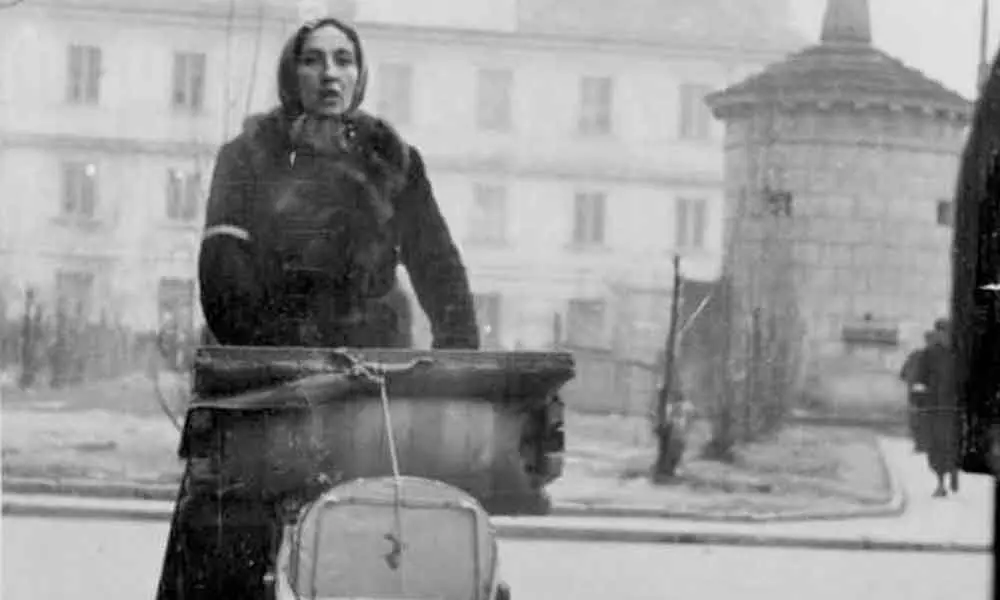Live
- CM Revanth Reddy Congratulates Telangana Athlete Deepti Jeevanji for Arjuna Award Selection
- China adds 10 US companies to unreliable entities list
- Telangana Government Announces January 3 as 'Women Teacher's Day' to Celebrate Savitribai Phule's Legacy
- Mithali Raj Supports AP’s Social Media Kindness Campaign
- Sajad Lone files PIL for fair police verification and rights of citizens
- Global Type 1 diabetes market to reach $9.9 bn by 2033: Report
- Record on New Year’s Eve, KSBCL Records Over Rs. 308 Crore in Liquor Sales
- Software Engineer from Hassan Dies by Suicide
- BJP is Politicising Contractor’s Suicide Case to Target Priyank Kharge- Bhandari
- India’s Solar Revolution, Surya Ghar Muft Bijili Yojana to Transform Energy Sector
Just In

Documentary pays homage to Jews victimised during World War II
Keeping alive the horrors of the genocide that the Nazis committed against the Jews is required for soul-searching and impressing upon the millennials...
Keeping alive the horrors of the genocide that the Nazis committed against the Jews is required for soul-searching and impressing upon the millennials to rise beyond caste, creed, race and religion.
Recently, the International Holocaust Remembrance Day was commemorated world over to recall the killing of six million Jews and 11 million others by the Nazi establishment led by Hitler.
Coinciding appropriately with this year's event is the DW DocFilm The Warsaw Ghetto: Memories of Horror, a touching film about the suffering that Jews had to undergo at the hands of the Nazis. The documentary was screened virtually by the India International Centre, New Delhi.
The 40-minute-long film, directed by Eric Bednarski, explains how the Warsaw Ghetto came into being, how the Jews -- both Polish and others -- brought from Europe, fared there. Besides the first-hand account of the Warsaw residents, including Jews, the film is insightful as it includes rare footage of an amateur 8 mm film shot by a Pole, Alfons Ziolkowski. He filmed the Ghetto, risking his freedom and life, and left for posterity, invaluable evidence.
All those Jews interviewed fondly remember the Warsaw they lived in. Krystya Budnicka says she spoke Yiddish and Polish, and had no problem with the Poles while Zygmunt Walkowski, recalls his Jewish neighbour and shopkeeper, who impressed him and other children by performing a trick of stitching his fingers.
Notably, Warsaw then, a major centre of Jewish life and culture boasted of more than 3.5 lakh Jews, the second largest in the world after New York City. As Chief Rabbi of Poland, Michael Schudrich puts it, "Jews were almost everywhere, and interacting with non-Jews daily."
All that bonhomie came to a halt with the Germans invading Poland in September of 1939, which they occupied from October till January 1945. Right from the beginning, the idea was to dismantle Warsaw and build a city for the Germans with no Jews. As Niels Gotschow, an architectural historian, remarks, "It was to reduce Warsaw next to nothingethe intention was to destroy the capital of Poland." With no capital, the concept of Poland would cease to exist.
Pursuing this objective, the Jews were isolated in a section of the city called Warsaw Ghetto, a settlement surrounded by a wall. The footage vividly depicts heart-wrenching scenes of families with children and individuals, carrying in the hands and carts, their meagre possessions, shifting to the Ghetto.
The displacement shattered them physically but also psychologically. Irena Agata Boldok who earlier lived in a decent neighbourhood, says she didn't want to live there and wanted to return. As a child on seeing a poster showing a Jew as evil, she says, "I didn't want to be a Jew." So deep was the psychic impact!
With hundreds packed like sardines, survival in isolation on meagre ration was a nightmare. Those with money or Polish friends managed to survive. Smuggling became rampant.
Ziolkowski's film shows little children with small packets and firewood bundles, passing them through holes in the wall. It has scenes showing a policeman beat up these kids with a broom and baton. A small boy battered mercilessly with the baton makes one revolt in anger!
The footage also shows the mass graveyard for burying the exterminated Jews, ironically located in a vast field right next to the Jewish cemetery. Intrigued by the sickening odour, Ziolkowski, enquired from a Jewish policeman, and learnt about it.
With the 1943 Uprising by the Jewish resistance opposing the transfer of the remaining Ghetto population to death camps, the place was burned down and its inhabitants killed. Walkowski in a pensive tone says the Germans wanted to cover the place with earth and create a park on the demolished ghetto, a garden paradise.
Amidst all this misery, the footage showing a group of Jews playing violin, drums, trumpet and accordion, displays the ray of hope the human race has even in the gravest of situations.
Bednarski weaves a seamless narrative through the interviews, footage and pictures making it an immersive viewing.
His last shot of the historic tram, which runs with a Star of David atop every year on January 27 to remind Warsaw residents of their murdered Jewish, returning to the depot, with the door slowly closing, has sub-text for the viewers. The haunting background score by Daniel Bloom fits well with the subject.

© 2024 Hyderabad Media House Limited/The Hans India. All rights reserved. Powered by hocalwire.com







